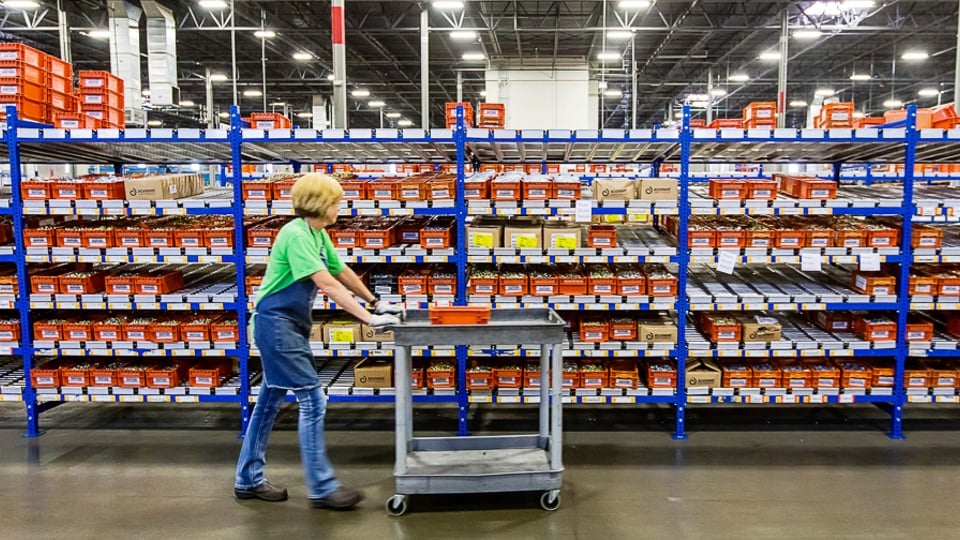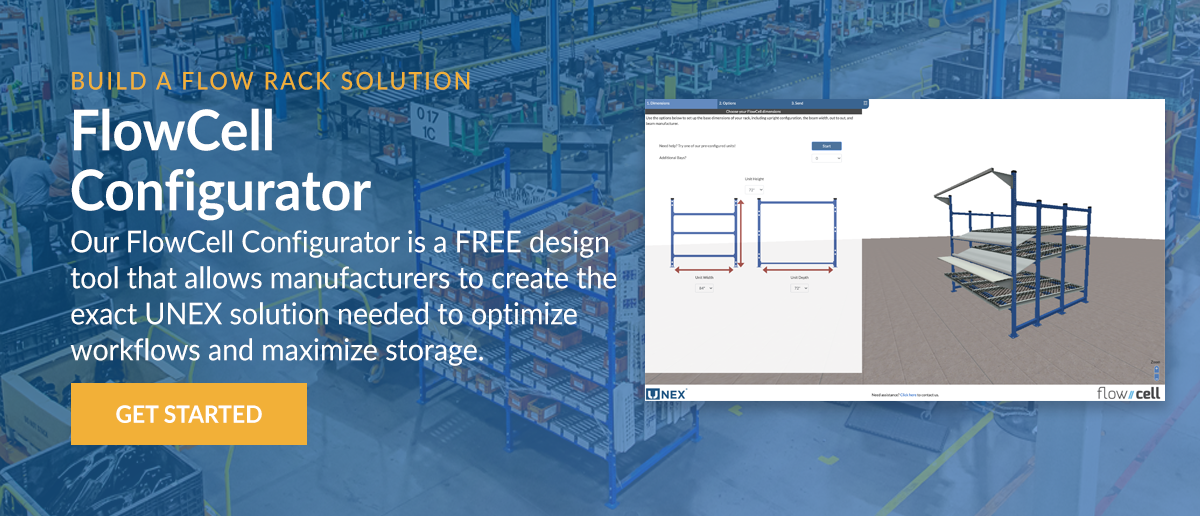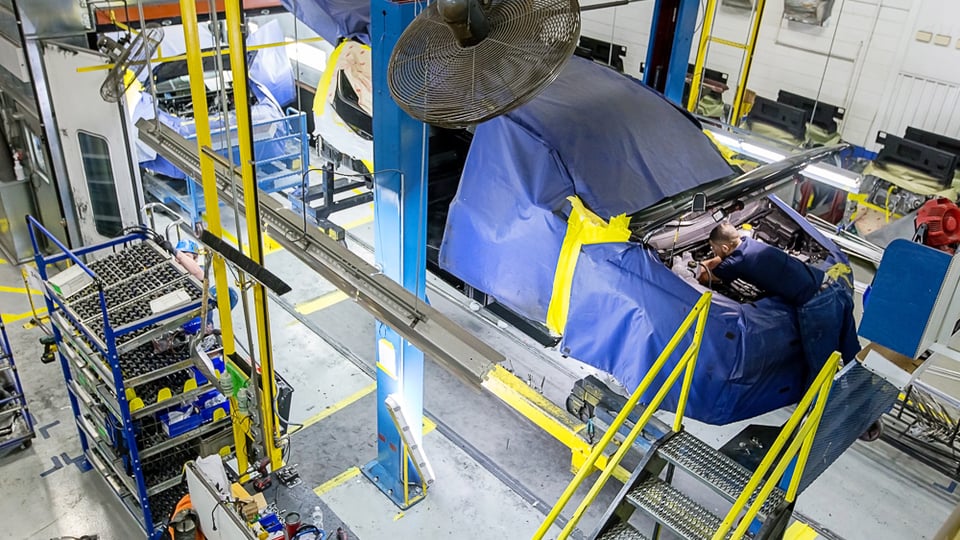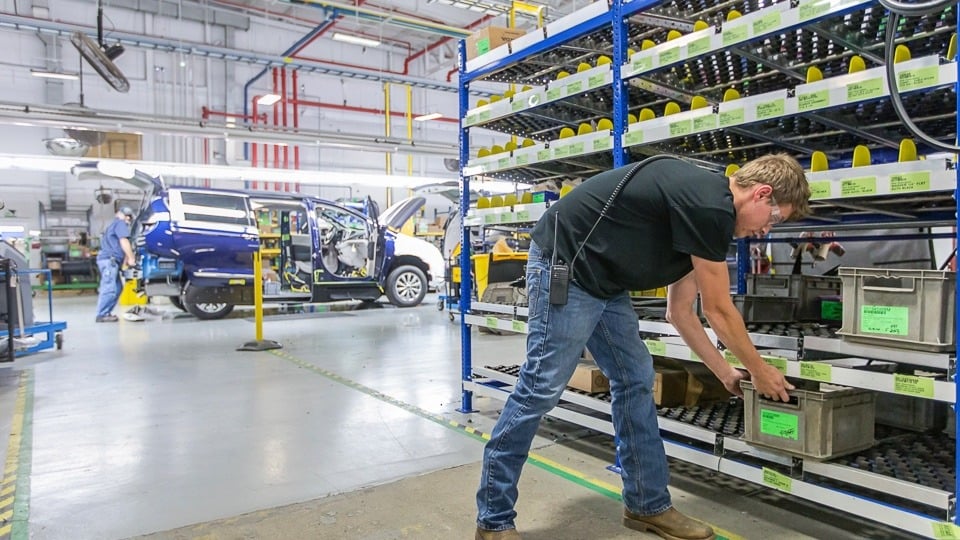Identifying and Eliminating the 7 Wastes of Lean Manufacturing

Key Takeaways
- The seven wastes of lean manufacturing are common sources of inefficiency that reduce productivity and increase costs.
- Identifying and eliminating these wastes is essential to creating a more streamlined, responsive, and cost-effective manufacturing operation.
- UNEX solutions like SpanTrack, FlowCell, Roller Rack, and Pick Shelves help address these challenges by improving flow, reducing motion, organizing materials, and supporting just-in-time practices.
Lean manufacturing emphasizes waste elimination and continuous improvement to increase efficiency and reduce costs. One of the key concepts of lean manufacturing is the seven lean wastes, also known as the seven forms of muda. Waste, in lean manufacturing terms, is any activity that does not add value to the product, costs resources, and earns the business nothing.
All seven wastes are ubiquitous in manufacturing operations, but understanding their causes and symptoms can help you more easily identify each. In this article, we'll describe the seven wastes, and explore how to identify and eliminate them in your facility.

1. Overproduction
Overproduction is the largest source of waste in the manufacturing industry. You create waste when you produce more than you need at the time. This can result in products becoming scrap or ending up in landfills. Overproduction occurs when you make more products than you need before you need them. Overproducing goods can cause bottlenecks and increase costs by creating additional kinds of waste. Overproduction is more than just creating too many goods, however. Facilities often overproduce things like paperwork, reports, meetings, and packaging, all of which waste resources.
2. Waiting
Unanticipated delays are ubiquitous in manufacturing operations. For many, time spent waiting is the second most costly form of waste. Rhythm is essential in manufacturing to ensure tools, materials, labor, and information are all available when you need them. Any disruption in that rhythm can create costly and wasteful delays. Mechanical problems, ineffective communication, and supply chain issues are common sources of delay.
3. Transportation
Transportation refers to not only moving goods from your facility to distribution centers, but also moving materials, equipment, and people within your facility. In both cases, creating the shortest, most efficient route saves time, money, and labor. Shipping routes as well as internal workflow design should be assessed for efficiency to keep the cost of all forms of transportation as low as possible.
Learn lean manufacturing storage principles. Download the Lean Manufacturing Storage Guidebook!

4. Overprocessing
Overprocessing occurs when you use more resources than needed to complete a task. This can result from a lack of standardization, inefficient automation, or incorrect assumptions about what is needed. Examples include adding valueless features, using unnecessarily expensive materials, or taking more steps than necessary to complete a task. While overprocessing often begins with the best intentions for quality, safety, and value, it’s important to safeguard against incurring superfluous costs in the production process.
5. Excess Inventory
Especially in the wake of supply chain disruptions that have marked recent years, it can be tempting to stock extra inventory “just in case.” However, this undermines efforts toward warehouse space optimization and results in unnecessarily high storage costs. It also requires you to expend more resources tracking, managing, and maintaining this excess inventory. A review of inventory management and supply chain will help eliminate waste in this area and allow you to further streamline your operation.
6. Motion
Motion waste arises from unnecessary movement of materials, machines, and personnel. Examples of motion waste include workers moving from one area of the warehouse to another to locate materials, machines that are not ergonomically designed, and inefficient layouts that require workers to move farther than necessary. Each of these scenarios can increase costs and reduce efficiency.
Optimizing your workplace layout can help reduce motion waste by minimizing the distance workers must move to complete production tasks. You can also implement lean work processes such as reducing the number of times workers need to move between workstations, using ergonomically designed machines, and organizing items to make them easier to locate. Automation can also reduce the of time and energy spent on tasks that require physical movement and manual labor.
7. Defects
Defects occur when a product fails to meet customer requirements or its design standard. Defects can happen in any part of the production process, from raw materials to the finished product. The costs associated with defects can include lost time, money, and materials as well as dissatisfied customers, which can damage a company’s reputation and reduce customer loyalty.
To reduce the impact of defects, manufacturers and warehouse managers must take proactive measures to identify and address them. This can include setting up a quality assurance system, conducting regular testing and inspections, and implementing corrective and preventive measures. Quality control is a continuous process that requires ongoing effort. Regular audits and reviews can ensure standards are being met and any defects are being addressed in a timely manner.
UNEX Solutions That Support Lean Manufacturing
Lean manufacturing demands smart, efficient solutions that improve organization, streamline material flow, and create more productive work environments. Strategic space optimization and storage systems play a critical role in eliminating inefficiencies across manufacturing operations, from reducing motion and wait times to minimizing inventory buildup and unnecessary handling. UNEX solutions are designed to address these challenges and support continuous improvement on the floor.
 SpanTrack: SpanTrack is a carton flow system that drops into existing pallet racks to create dynamic, gravity-fed storage lanes. By keeping inventory constantly moving forward and always within reach, SpanTrack minimizes wasted motion and transport within the warehouse. It also supports first-in, first-out (FIFO) inventory rotation, helping facilities maintain product quality and reduce the risks of expired or obsolete stock. With fewer touches and less travel, teams work more efficiently while improving pick accuracy and throughput.
SpanTrack: SpanTrack is a carton flow system that drops into existing pallet racks to create dynamic, gravity-fed storage lanes. By keeping inventory constantly moving forward and always within reach, SpanTrack minimizes wasted motion and transport within the warehouse. It also supports first-in, first-out (FIFO) inventory rotation, helping facilities maintain product quality and reduce the risks of expired or obsolete stock. With fewer touches and less travel, teams work more efficiently while improving pick accuracy and throughput.
 FlowCell: FlowCell is a modular workstation solution that brings tools, parts, and supplies directly to the point of use. Designed for flexibility, FlowCell can be configured to suit specific production tasks or assembly lines, promoting just-in-time inventory practices and reducing clutter. It helps eliminate overprocessing and motion waste by keeping everything a worker needs in one compact, organized, and ergonomic space. This leads to faster task completion, fewer delays, and a safer, more productive environment.
FlowCell: FlowCell is a modular workstation solution that brings tools, parts, and supplies directly to the point of use. Designed for flexibility, FlowCell can be configured to suit specific production tasks or assembly lines, promoting just-in-time inventory practices and reducing clutter. It helps eliminate overprocessing and motion waste by keeping everything a worker needs in one compact, organized, and ergonomic space. This leads to faster task completion, fewer delays, and a safer, more productive environment.
 Roller Rack: Roller Rack combines the structural strength of UNEX racking with the flow benefits of SpanTrack. These standalone units are ideal for creating high-density picking and staging zones without relying on traditional shelving or pallet positions. Roller Rack supports lean layouts by reducing storage footprints, improving visibility, and enabling efficient replenishment. With clearly designated pick faces and organized flow lanes, this solution minimizes waiting, excess inventory, and confusion in fast-paced operations.
Roller Rack: Roller Rack combines the structural strength of UNEX racking with the flow benefits of SpanTrack. These standalone units are ideal for creating high-density picking and staging zones without relying on traditional shelving or pallet positions. Roller Rack supports lean layouts by reducing storage footprints, improving visibility, and enabling efficient replenishment. With clearly designated pick faces and organized flow lanes, this solution minimizes waiting, excess inventory, and confusion in fast-paced operations.
 Pick Shelves: Pick Shelves are angled steel shelving systems designed to improve visibility, accessibility, and organization for smaller parts and tools. By presenting products at an ergonomic angle, Pick Shelves reduce the need for reaching and bending, which directly addresses motion waste. They are especially useful in assembly areas or maintenance stations where quick access and visual control are essential. Clean, organized shelving also supports 5S initiatives and makes it easier to maintain standard work environments.
Pick Shelves: Pick Shelves are angled steel shelving systems designed to improve visibility, accessibility, and organization for smaller parts and tools. By presenting products at an ergonomic angle, Pick Shelves reduce the need for reaching and bending, which directly addresses motion waste. They are especially useful in assembly areas or maintenance stations where quick access and visual control are essential. Clean, organized shelving also supports 5S initiatives and makes it easier to maintain standard work environments.
Eliminate Waste in Your Facilities with UNEX Solutions
By understanding and eliminating the seven wastes, you can create a more streamlined and efficient production process across your operation. If you’re ready to eliminate waste and streamline your facilities, UNEX can help! Learn more about UNEX solutions for lean manufacturing.
Take proactive measures to improve your productivity and achieve greater success in your facility by contacting us today.



